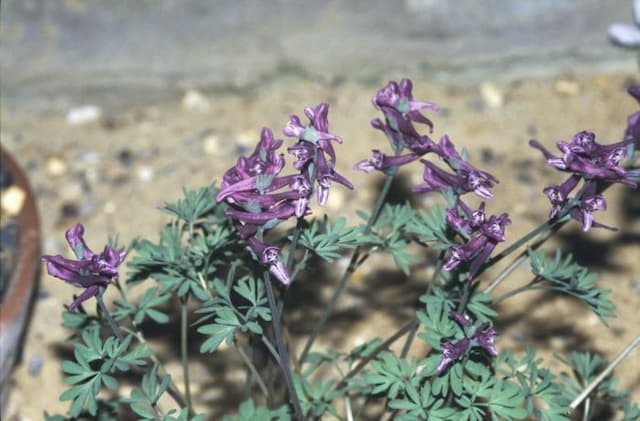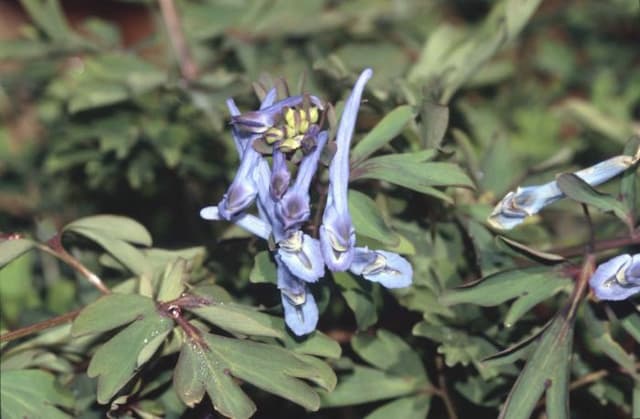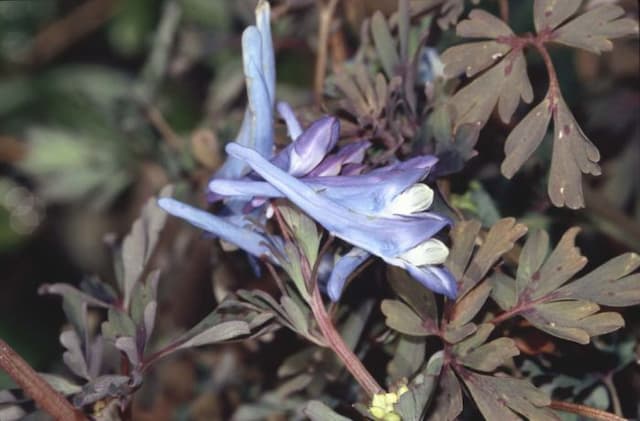Welsh poppy Papaver cambricum

ABOUT
The plant in question, commonly known as Welsh poppy, displays a delicate and graceful appearance. It features thin, gracefully arching stems that are light green to slightly glaucous in color. Upon these stems rest airy, fern-like leaves that are deeply divided into lobes, giving them a soft, feathery look that adds to the plant's overall texture. The Welsh poppy is particularly celebrated for its charming flowers. These blooms are characteristically bright and cheerful, most often found in shades of yellow and occasionally in soft oranges. Each flower comprises four broad, rounded petals that form a cup-like shape, creating a simple yet striking display. At the center of the flower, a group of prominent stamens can be seen, often contrasting in color, which adds to the visual interest of the plant. The Welsh poppy has a particularly ephemeral beauty, as the flowers appear delicate and are typically short-lived. They can be seen nodding gently in the breeze, exuding a certain poignancy. Despite their fleeting nature, the poppies continually bloom over a period, often from late spring to early autumn, ensuring a long-lasting display of color. In summary, the Welsh poppy is a plant of subtle beauty with its feathery foliage and radiant, cup-shaped flowers, presenting a wildflower charm that is highly valued in garden settings for its ability to bring a splash of bright color and a gentle, naturalistic feel.
About this plant
 Names
NamesFamily
Papaveraceae
Synonyms
Welsh Poppy, Yellow Poppy, Meconopsis Cambrica
Common names
Meconopsis cambrica, Papaver aurantiacum, Papaver calycinum, Papaver croceum, Papaver luteum.
 Toxicity
ToxicityTo humans
Welsh Poppy (Papaver cambricum) is considered to have a low level of toxicity to humans. Although not as toxic as some of its related species, consuming any part of the plant can still potentially result in mild stomach upset. Being a member of the poppy family, it contains alkaloids that might cause harm if ingested in large quantities. The symptoms of poisoning are typically not severe, but they may include nausea, vomiting, and diarrhea. It is essential to seek medical attention if ingestion occurs and symptoms appear.
To pets
Welsh Poppy (Papaver cambricum) can be toxic to pets if ingested. Similar to humans, it has a low to moderate level of toxicity for most animals. The primary concern is the alkaloids present in the plant, which can cause mild to moderate digestive upset, including vomiting and diarrhea. In high enough doses, these alkaloids may affect the central nervous system, leading to more severe symptoms such as sedation or lethargy. Pet owners should prevent animals from eating the plant and consult a veterinarian if they suspect their pet has ingested any part of the Welsh Poppy.
 Characteristics
CharacteristicsLife cycle
Perennials
Foliage type
Deciduous
Color of leaves
Green
Flower color
Yellow
Height
1 foot [30 cm]
Spread
1 foot [30 cm]
Plant type
Herb
Hardiness zones
8
Native area
Europe
Benefits
 General Benefits
General Benefits- Attracts pollinators: Papaver cambricum, commonly known as Welsh poppy, attracts bees and other pollinating insects, which is beneficial for the ecosystem.
- Aesthetic appeal: The bright yellow or orange flowers of the Welsh poppy add a splash of color to gardens and natural landscapes.
- Low maintenance: Welsh poppies are relatively easy to care for, requiring minimal watering and no fertilization.
- Shade tolerance: Unlike many flowering plants, the Welsh poppy can thrive in shaded areas, making it a versatile choice for different garden locations.
- Resilience: Welsh poppies are hardy plants that can survive in a variety of soil types and weather conditions.
- Self-seeding: They can self-seed prolifically, ensuring a continuous presence in the garden without the need for replanting.
- Naturalization: The Welsh poppy can naturalize in a garden setting, creating a natural, wildflower look.
- Wildlife support: They provide a food source for caterpillars of certain moth species, supporting biodiversity.
- Ground cover: When grown en masse, Welsh poppies can act as ground cover, preventing soil erosion and suppressing weeds.
 Medical Properties
Medical PropertiesThis plant is not used for medical purposes.
 Air-purifying Qualities
Air-purifying QualitiesThis plant is not specifically known for air purifying qualities.
 Other Uses
Other Uses- Papaver cambricum, also known as Welsh poppy, can be used as a natural dye, providing yellow to orange hues, depending on the mordant used.
- In garden design, Welsh poppy's self-seeding ability allows it to fill spaces in wild garden landscapes or rock gardens, creating splashes of color without manual replanting.
- Welsh poppy’s nectar and pollen can attract beneficial insects such as bees and butterflies, supporting local biodiversity.
- The petals of Welsh poppy have been traditionally used for their color in artisanal crafts, such as pressed flower art.
- Children sometimes use the hollow stems of Welsh poppies for creating natural blowguns, a harmless play activity reminiscent of their use of grass stems.
- The seed pods of Welsh poppies can be used in dried floral arrangements, adding an interesting shape and texture to the composition.
- In photography and painting, the vibrant colors and delicate structure of Welsh poppies provide aesthetic value as subjects for artistic representation.
- Eco-friendly confetti can be made from the dried petals of Welsh poppies, decomposing naturally and reducing waste at outdoor celebrations.
- The bright flowers of Welsh poppies can be floated in water bowls as a decorative element for garden parties or informal outdoor events.
- Teachers and educators sometimes use Welsh poppies in botanical studies to show students the life cycle of a flowering plant, from seed germination to seed dispersal.
Interesting Facts
 Feng Shui
Feng ShuiThe Welsh Poppy is not used in Feng Shui practice.
 Zodiac Sign Compitability
Zodiac Sign CompitabilityThe Welsh Poppy is not used in astrology practice.
 Plant Symbolism
Plant Symbolism- Remembrance: Papaver cambricum, commonly known as the Welsh Poppy, is often associated with remembrance, especially in the context of remembering fallen soldiers during wartime due to its close relation to the red poppy used as a symbol for Remembrance Day.
- Peace: The poppy has also been a symbol of peace, as people wish to remember the past and hope to prevent future conflicts.
- Rest: In mythology, poppies were used as offerings to the dead and are often connected to sleep, rest, and eternal slumber, which is associated with the opiate properties of some poppies.
- Resilience: The Welsh Poppy's ability to grow in inhospitable and rocky terrains has made it a symbol of resilience and perseverance in the face of adversity.
 Water
WaterWelsh poppies should be watered moderately, ensuring the soil is evenly moist but not waterlogged. During the growing season, approximately every week, provide about 1 inch of water, which equals about 0.5 gallons per square foot of soil. Adjust frequency during periods of rainfall, reducing the need for supplemental watering. In the winter or during dormancy, reduce watering to prevent root rot. Overwatering can be more detrimental than under-watering for this plant, so it's better to err on the side of caution.
 Light
LightWelsh poppies thrive in areas with full sun to partial shade. The ideal spot for these plants would be an area that receives morning sunlight and is sheltered from the intense afternoon sun. Adequate light is essential for the best flower production but too much direct hot sun can lead to scorching of leaves.
 Temperature
TemperatureWelsh poppies prefer temperate climates with a preference for cooler conditions. They can tolerate temperatures down to about 30 degrees Fahrenheit and up to around 85 degrees Fahrenheit. The ideal temperature range for growing Welsh poppies would be between 50 and 75 degrees Fahrenheit, which promotes healthy growth and flowering.
 Pruning
PruningWelsh poppies may benefit from deadheading, which is the removal of spent flowers to encourage additional blooming. Prune back foliage in the fall, after flowering has ceased, to keep the plant tidy. Pruning is typically not required often—do so only to remove dead or damaged plant material or to control size. The best time for pruning Welsh poppies is when the flowers have faded, and the plant begins to die back naturally.
 Cleaning
CleaningAs needed
 Soil
SoilThe best soil mix for the Welsh Poppy (Papaver cambricum) is well-draining and fertile, with a mix of loam, sand, and peat or compost. A neutral to slightly acidic pH, between 6.0 and 7.0, is ideal for this plant.
 Repotting
RepottingWelsh Poppies (Papaver cambricum) are often grown as annuals or biennials, and typically do not require repotting. If grown as perennials, they prefer not to be disturbed and are best left undisturbed for several years.
 Humidity & Misting
Humidity & MistingWelsh Poppies (Papaver cambricum) prefer outdoor conditions with natural humidity and do not require any special humidity adjustments when grown outside.
 Suitable locations
Suitable locationsIndoor
Provide bright light and well-draining soil.
Outdoor
Plant in partial shade, well-drained soil, and water regularly.
Hardiness zone
5-9 USDA
 Life cycle
Life cycleThe Welsh poppy (Papaver cambricum) begins its life as a seed, often lying dormant in the soil through winter until conditions are favorable for germination in the spring. Upon germinating, it develops a small rosette of leaves at the soil level, prioritizing root establishment and foliage growth. As it matures, it sends up flowering stems usually in late spring or early summer, where solitary, yellow or orange flowers bloom on long stalks. After pollination, typically by insects attracted by the bright flowers, the plant sets seed in a capsule that, when ripe, splits open to release numerous tiny seeds. The seeds are dispersed by wind, water, or animal activity, allowing the Welsh poppy to colonize new areas where the cycle starts anew. In favorable conditions, it may exhibit a biennial or short-lived perennial life cycle, resprouting from the rootstock for several years before it completes its life span.
 Propogation
PropogationPropogation time
Spring-Early summer
The Welsh poppy, or Papaver cambricum, is most commonly propagated by seed. The best time to sow the seeds is during late winter or early spring. The propagation process involves scattering the seeds over the surface of well-drained soil in pots or trays and lightly pressing them into the soil, but they should not be completely covered as they require light for germination. The pots or trays should be kept in a cold frame or sheltered outdoor area until the seedlings are large enough to handle, at which time they can be transplanted into their final growing positions. The Welsh poppy can readily self-seed in the garden if conditions are favorable, often leading to natural propagation without gardener intervention.









